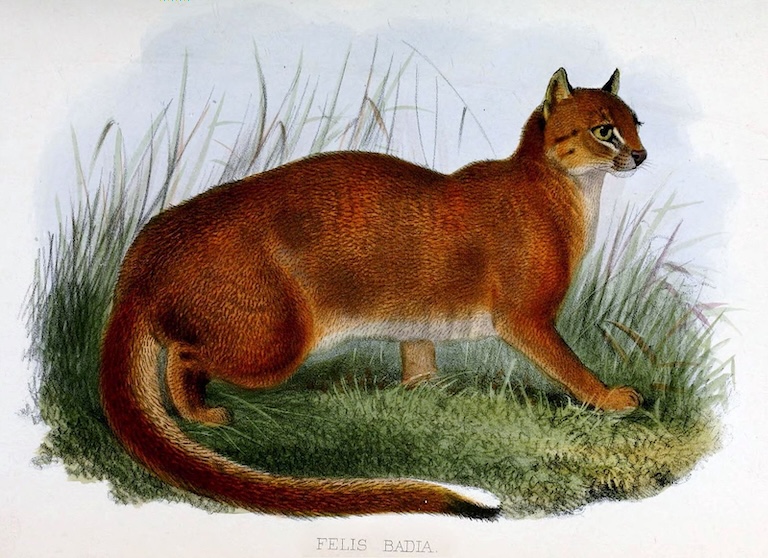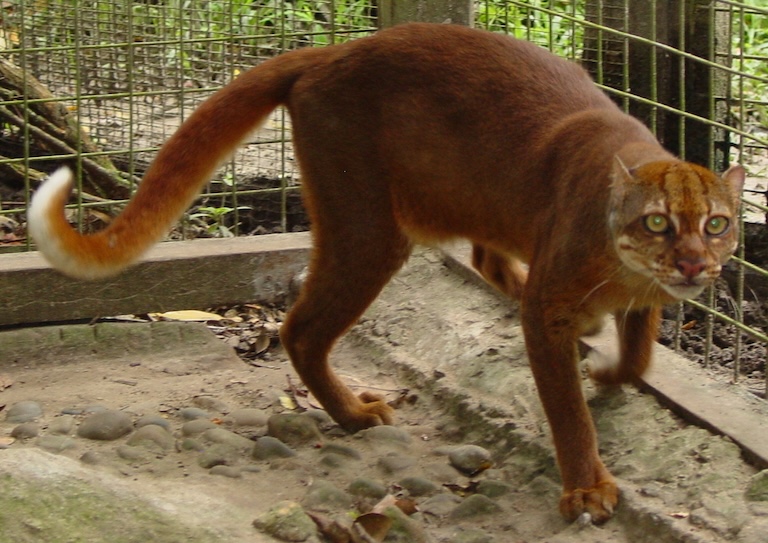Bay Cat Profile
Nikolai Alekseevich Severtzov was a true 1800s naturalist. He wore sabre scars from his kidnapping by the Turks while studying the Ural Steppes, contributed ground-breaking research on birds to several 19th-century journals and died in a frozen river in Southern Russia trying to rescue his portfolio on birds.
Unfortunately, he was primarily an ornithologist, which might explain why, when tasked with naming a cat, he was (at least partially) responsible for the truly inelegant binomial: Catopuma badia.
While the bay cat may or may not be as into birds as Severtzov, it would never be so naïve to underestimate a Russian winter.

Bay Cat Facts Overview
| Habitat: | Dense, tropical forest |
| Location: | Borneo |
| Lifespan: | Unknown |
| Size: | Up to 67 cm (26 in) long with a 40 cm (16 in) tail |
| Weight: | Possibly up to 5 kg (11 lb) |
| Colour: | Brown, darker on top, paler underneath, sometimes grey. |
| Diet: | Small rodents and birds, carrion, and even monkeys |
| Predators: | Unknown |
| Top Speed: | Unknown |
| No. of Species: | 1 |
| Conservation Status: | Endangered (ICUN) |
Bay cats are some of the rarest mammals on the planet, and their elusive nature, low population densities and nocturnal shenanigans make them an almost mythical presence in the ever-decreasing primary forest of Borneo.
Unfortunately, the skills that kept the species safe from subsistence hunters for thousands of years now work against conservationists, who are trying to piece together enough information to protect them.
Interesting Bay Cat Facts
1. They’re relatives of the golden cat
Severtzov was only responsible for the Catopuma part of this poor animal’s name.
Before it made it into the genus, the bay cat was lumped into a genus known as Badiofelis, which already sounds clumsy, but the badio- prefix actually refers to the Latin word for brown, and this makes the name a little more objective than it first appears.
Catopuma contained just one species: the Asian golden cat until the Bay cat was identified as a close relative and put alongside it.
Until very recently, much of Southeast Asia was a solid lump, with today’s islands existing as hilly peaks.
But the Ice Age ended and sea levels rose to cover the lowest regions, isolating what are now islands like Borneo, and the bay cat’s spot in this location is due to this process.
In that time, they became experts at hide and seek.

2. They were thought to be extinct
In 1992, local hunters trapped a bay cat and kept it in captivity for several months until it died. Then, they took its body to a museum, and it became the seventh specimen of the species ever to be recorded.
Until that time, there had been no confirmed sightings since 1928, and researchers spent some time trying to conclude that it was, indeed, a bay cat.
Here was an animal that nobody had seen in over sixty years, that even local people barely knew about.
But for those who know where to look, the bay cat has a distinctive characteristic identifier. 1
3. They’ve got weird teeth
When differentiating species from one another, it’s useful to find something unique, but with so many similar animals around, often these quirks are quite small.
Many animals are identified only by their genitals, which are mostly unique because they evolve in relation to the male and female reproductive arms race within the species rather than the direct impacts of the external environment and so are rarely involved in cases of convergent evolution.
Other times it’s something equally small and hard to find; while there don’t appear to be any available dick pics of the bay cat online, in this animal’s case it’s a tooth that sets it apart from the rest.
The first upper premolar is smaller than normal, has a short, rounded head, and only one root. This little piece of information is surprisingly significant to understanding the animal’s phylogeny since there are no fossils of it known.
And even real specimens are remarkably rare. 2 3
4. That’s about all we know
The majority of scientific knowledge about this species comes from a mere seven specimens, six of which were collected from 1855 to 1928. The most recent was collected in 1991, and there have been almost no sightings in the wild.
In 2012, a team captured photos of the bay cat on camera traps which made the journals. The fact that they had never been reported in that location before demonstrated a wider range than was previously known, and a higher altitude for the animal that had ever been recorded.
And this is exactly the sort of scant and outdated evidence researchers are still trying to piece together to figure out the bay cat’s position in the ecosystem. 4
5. This is one of the rarest cats in the world
It appears that not only is this cat an expert at hiding, but it’s also prone to low population densities. Still, the exact nature of its population is entirely a mystery.
It’s said that the cat is a fearsome hunter that can take on prey even larger than itself, and is a nocturnal hunter that will also take carrion if it’s fresh enough.
However, some of these claims seem hard to verify, and there is nothing said about its reproduction or social behaviour.
6. There is a desperate need for its conservation
Back in the day, being elusive would have served this species well.
Subsistence hunters in small island populations take a long time to cause any meaningful damage to an ecosystem, especially if they can’t find an animal, but as human populations explode, what would have been an inherently sustainable practice of taking meat and wood from the forest tips into exponential destruction.
Borneo has some of the most ancient forests on Earth and they are currently facing the consequences of unchecked global capitalism. Palm oil plantations and illegal logging are the two main culprits, and while the bay cat is an expert at hiding, it still needs a place in which to hide.
The IUCN report dates back as far as 2017, woefully out of date for a species in such steep decline, and the lack of research on the species makes its conservation very difficult.
According to the IUCN report, “A detailed study of the Bay Cat’s basic ecology, including its diet and dispersal abilities is of the highest priority”.
Bay Cat Fact-File Summary
Scientific Classification
| Kingdom: | Animalia |
| Phylum: | Chordata |
| Class: | Mammalia |
| Order: | Carnivora |
| Family: | Felidae |
| Genus: | Catopuma |
| Species: | badia |
Fact Sources & References
- Mel Sunquist (2009), “Rediscovery of the Bornean bay cat”, Oxford University Press.
- “Catopuma”, Science Direct.
- Adrienne Davis, “Catopuma badia bay cat”, Animal Diversity Web.
- Anthony J Giordano (2012), “New high elevation record of the bay cat (Pardofelis badia) from Malaysian Borneo”, Academia.
